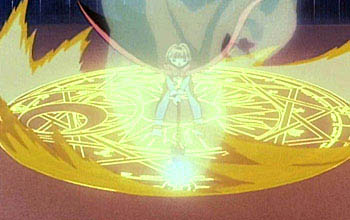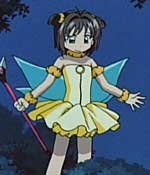
Since its release in April of last year, the hype surrounding the North American importation of "Card Captor Sakura" has waned. But "Cardcaptors" (the title of the western hemisphere incarnation) has maintained a modest level of popularity, leaping from a WB run to its sister network Cartoon Network (both companies fall under the administrative umbrella of the mega corporation AOL/Time Warner and Turner Broadcasting) this month. The Vancouver-based Nelvana Limited, responsible for innocuous family hits such as "Babar" and "Rolie Polie Olie," acquired the 70-episode "Card Captor Sakura" in the fall of 1999, marking the company's first foray into serial anime. Soon after its release, "Cardcaptors" enjoyed a tepid mix of accolades and indifference, but incurred very little scorn or even criticism from the mainstream community. Journalist Thelma Adams, in a piece for the New York Post, praised the show's intelligence, non-condescension to its audience, its re-enforcement of "girl power" themes sounded by "Sailor Moon" and "Power Puff Girls," and its ability to set an effective pace outside the frenetic rhythm of commercialism.
"Unlike the current 'Animaniacs,' which makes me beg for a dose of Ritalin, 'Cardcaptors' isn't hyperactive and over-reliant on slapstick," Adams writes. The fan response ranged from indifference to outright vehemence. One irate fan of the original Japanese series developed a comparison page http://www.ccsvscc.com/ that opens: "Welcome to CCS vs. CC, where Kestrel will non-objectively compare the superior 'Card Captor Sakura' with the abomination known as 'Cardcaptors.'" Kestrel, wearing his biases on his forehead, moves through the adaptation more or less like an epicurean at a hot dog stand. On the more temperate front, a similar site entitled "Cardcaptors Uncensored" features an episode by episode comparison of the Japanese and English versions of the show. This highly detailed database (similar in philosophy to several "Dragonball Z" episode comparisons) catalogues individual cuts and additions throughout the series.
So what's all the fuss about? In a nutshell, the problem stems from "Cardcaptors" and "Card Captor Sakura" being outfitted for two different audiences. "Card Captor Sakura," created by the artistic quartet Clamp and animated by Madhouse, is a shoujo series with all the trimmings: Sakura's innocent crush on Yukito; darlingly cute character voices and adorable creatures; an indelible bond between best friends Sakura and Tomoyo; and the emphasis on fashion punctuated by "Sakura's" "Leave it to Kero-chan" Corners. And Sakura is the unmistakable central focus of the series, a strong female protagonist that faces and successfully surmounts challenges. (Read Lisa Klassen's review of "Card Captor Sakura".) |



